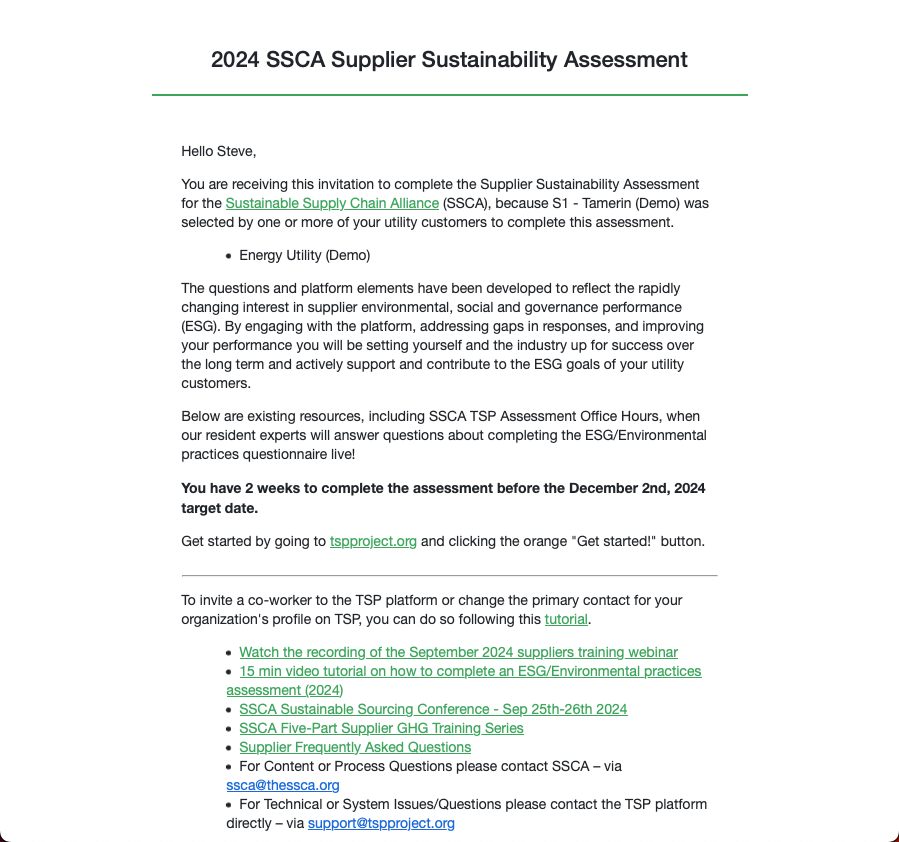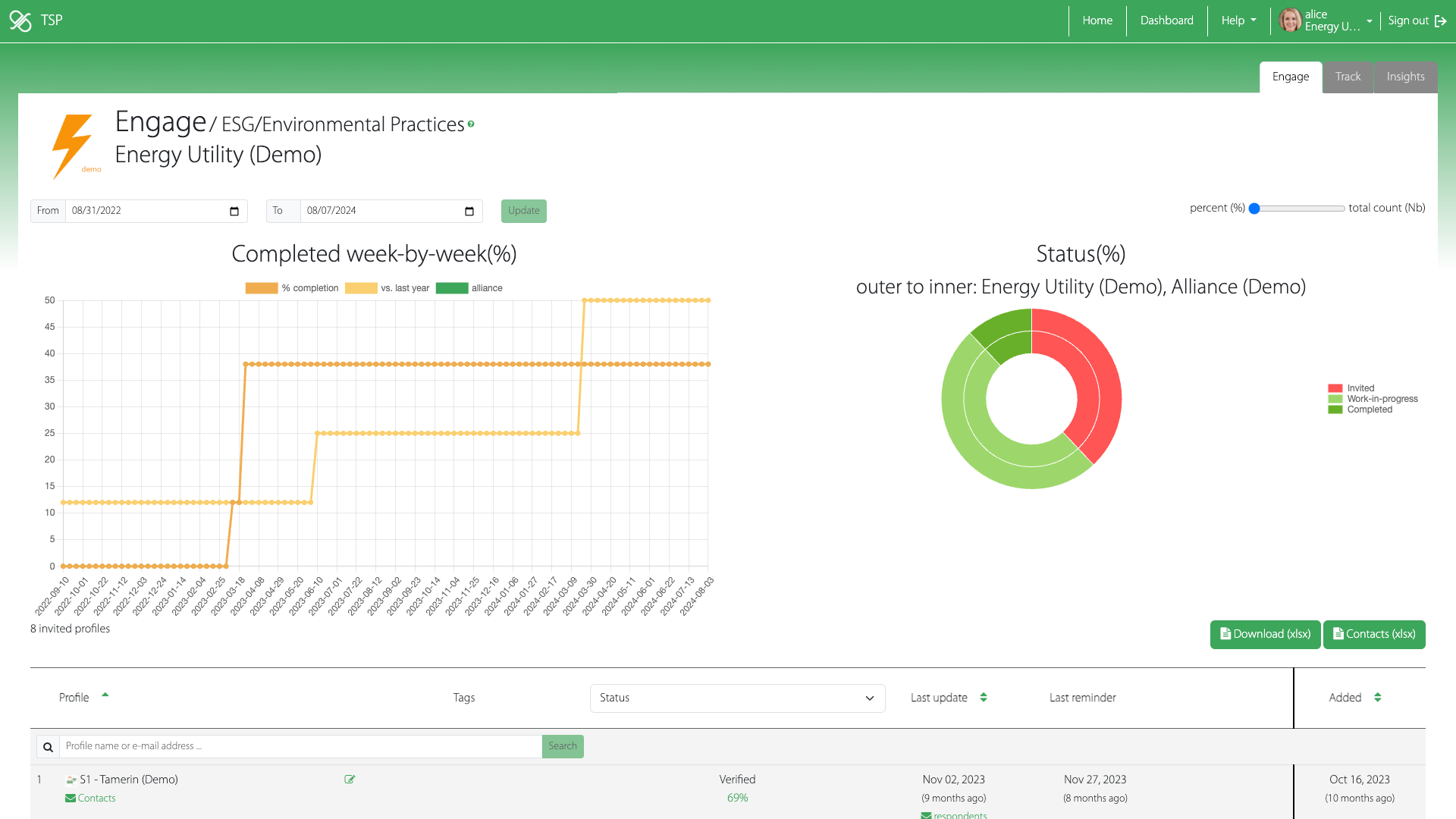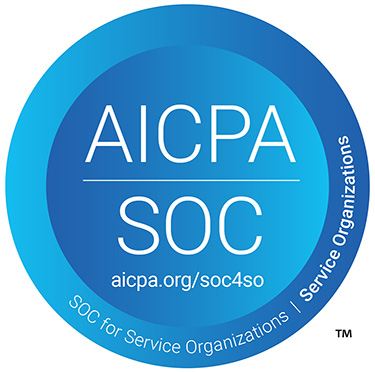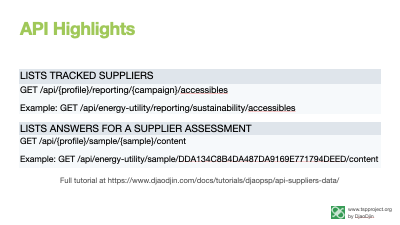Frequently Asked Questions
General
I have received a request to answer the sustainability practices questionnaire. What next?
TSP (tspproject.org) helps organizations gain a better understanding of how their valued suppliers are considering and managing environmental impacts and opportunities, in order to identify and address opportunities to create a more sustainable supply chain.
If you have received a request to answer the sustainability questions as part of a bid package, sourcing event, or as part of an annual assessment, please follow the Responding to a questionnaire.
Resources listed in the SSCA Supplier Sustainability Assessment invite e-mail:
- 2025 September SSCA training webinar
- 15 min video tutorial on how to complete an sustainability practices assessment (2025)
- SSCA Sustainable Sourcing Conference - Sep 18-19 2025
- SSCA Five-Part Supplier GHG Training Series
- Supplier Frequently Asked Questions
- For any questions, comments or general feedback, please contact us.

Why did I get a "Company X requested your scorecard on TSP" email?
A current or prospective client/customer/investor is using TSP as their platform for evaluating supplier maturity in environmental management (e.g. as part of an RFP process, or a socially responsible investment strategy).
If you have already completed an assessment on TSP, you can go ahead and share your scorecard with the requester.
If this was the first time you have been invited to take an assessment on TSP, review the short tutorials for help on how to take an assessment and share your resulting scorecard.
Why did I get a "You were added as a profile manager..." email?
The person who triggered the email to you is a Profile Manager of your organization’s information on TSP. They wish to grant you similar access rights on the system to theirs.
As a Profile Manager, you have access to the core functions of the site i.e.:
- Learn - Browse practices applicable to your industry segment.
- Measure - Complete an assessment of your organization against practices and see how you benchmark with peers.
- Improve - Select high value improvement actions to implement.
As a Profile Manager, you also have administrative access to the site, which allow you to invite other parties to be:
- Profile Managers.
- Contributors - who can help complete the Self Assessment and Improvement Planning information.
- Viewers - who can review the information in the profile without altering it.
The person who triggered the email should follow-up with you to explain why they are inviting you to be a Profile Manager. To learn more about the functions of TSP on your own, browse the tutorials.
Questionnaires and responses
How frequently does an Assessment need to be completed?
The full assessment gets completed once. This creates a baseline record against which you may record any improvements you make over time. We recommend you keep the response up-to-date with your organization's achievements at least once a year.
If practices are added to TSP, will that affect my Assessment results?
No. There will no change your baseline score, or any subsequent improved scores. New practices and your score against same will only be factored in to the next Assessment update you choose to record in the system.
How to read a supplier response?
A sustainability core scorecard is composed of 3 parts:
- Summary section
- Answers to the sustainability core section
- Answers to industry-specific sustainability practices - optional
The summary section gives a quick bird-eye view on key answers. While the sustainability core section is focused more on policies, management and reporting, industry-specific sections present an assessment of actionable sustainability practices. These practices can be implemented as part of an improvement plan.
You can read more details in this tutorial.
How does benchmarking work?
Your relative position against peers in your industry segment is shown in the “Benchmark graph” section of your Scorecard. Benchmark positions may change over time as more respondents from your industry peer group respond to the Assessment, so it is important to check back into the system from time to time to monitor for updates in the benchmark outcome. Learn more on how scoring works.
Reporting dashboard
How do I get access to a suppliers reporting dashboard?
If you are a member of an industry Alliance that sponsors TSP, you will have access to suppliers reporting dashboards through your Alliance membership. It usually involves sending the primary contacts for your organization to the Alliance administrators.
If you are not part of an industry Alliance that sponsors TSP, you can review pricing, and contact us to get access to suppliers reporting dashboards.
In all cases your own suppliers reporting dashboards will be up and running within 24h of receiving confirmation of the primary contacts at your organization.

How to find the latest completed responses?
The Engage dashboard list suppliers you requested a response from within a specific timeframe. The Track dashoard list all available responses your organization has access to on TSP, whether you requested a response in prior years, or the supplier pro-actively shared a response with your organization (maybe as part of a RFP).
How to find if a supplier logged in after I contacted them?
Click Contact under the name of the supplier on the Engage dashboard to list all contacts at the supplier with an account on TSP, and the latest time they logged in.
Technical
Will the data provided be shared? With who?
The purpose of The Sustainability Project (TSP) is to promote best practices across entire supply chains. The data provided is not used for any other purposes.
The answers to questionnaires are anonymized and aggregated so you can compare your own organization against peers responding to these questionnaires.
In order to provide high-quality baselines and comparison charts, TSP has independent third-party data verifiers review answers and supporting documentation to grade the confidence in supplier responses. This process enables your customers to respond to CDP and other reporting agencies.
TSP encourages you to provide any supporting documentation as public links to a Website you own whenever possible (ex: your organization’s public sustainability report).
The detailed individual answers, comments, and uploaded documentation are only shared with the organizations you elect. All customers you have shared information with are available by clicking the Historical assessments link in the Assess section after you log in. These customers will have access to your completed response, exactly as it appears on the REVIEW step.
If you need to show your organization responded to the assessment, but do not wish to share the response with customers, you can also do so by clicking “Complete”, and then denying a customer request to access your organization's detailed response. The customer will see that your organization has responded (and thus can count it in their supplier engagement numbers), but will not have access to the detailed response.
TSP advises customers you share information with to keep it confidential, but cannot enforce they will do so. Therefore we recommend you upload documents that require a reasonable expectation of confidentiality, but nothing that could be considered business trade secrets.
For more uses of the data provided by customers, please contact your customers directly. We will provide you with your customers' primary contact for TSP upon request. A primary contact will be able to answer your questions with regards to the customer internal process, and their intended use of the data provided.
For any questions, please contact us.
How is data provided secured?
TSP uses both technical solutions and data management policies to insure information is only accessed by authorized users and entities.
All hosting machines are located in the United States. All data is encrypted, both at-rest and in-transit. Data access is checked on each request by a RBAC gateway. Access is only granted once a user session passes a set of explicit and easily auditable access rules.
All users must have a unique login per the terms of use. Accounts sharing is not allowed. Registering as many users for your organization as necessary to manage the reporting process is free. If you want to connect your organization profile to a SSO provider, please contact us.
For more details, see Security policy.
| Supplier 1 | Supplier 2 | Customer A | Customer B | |
|---|---|---|---|---|
| Supplier 1 assess | ||||
| Supplier 2 assess | ||||
| Supplier 1 scorecard | with double opt-in | with double opt-in | ||
| Supplier 2 scorecard | with double opt-in | with double opt-in | ||
| Customer A dashboard | ||||
| Customer B dashboard | ||||
| Aggregate trends |

SOC 2 & GDPR compliant
TSP data handling systems and processes are independently audited and certified.

GEOGRAPHICAL LOCATION
All hosting machines are located in the United States.
ENCRYPTED DATA IN TRANSIT
All HTTP requests to tspproject.org are done through TLS.
ENCRYPTED DATA AT REST
EBS disk volumes on which databases are stored is encrypted using the industry-standard AES-256 algorithm.
ROLE-BASED ACCESS CONTROL (RBAC)
User session management is implemented through an enterprise-grade RBAC gateway.
Is there any API access?
Being built on Open Source, and a Practices Survey Platform that powers a portfolio of Web properties, all TSP features are available through API endpoints.
To learn more you can download the TSP API presentation below (PDF), and/or browse a tutorial on API Access to suppliers responses.
Don't see what you're looking for?
If you cannot find what you are looking for, or have questions, comments or feedback with regards to TSP, please contact us.
- Need additional help?
- Contact us
